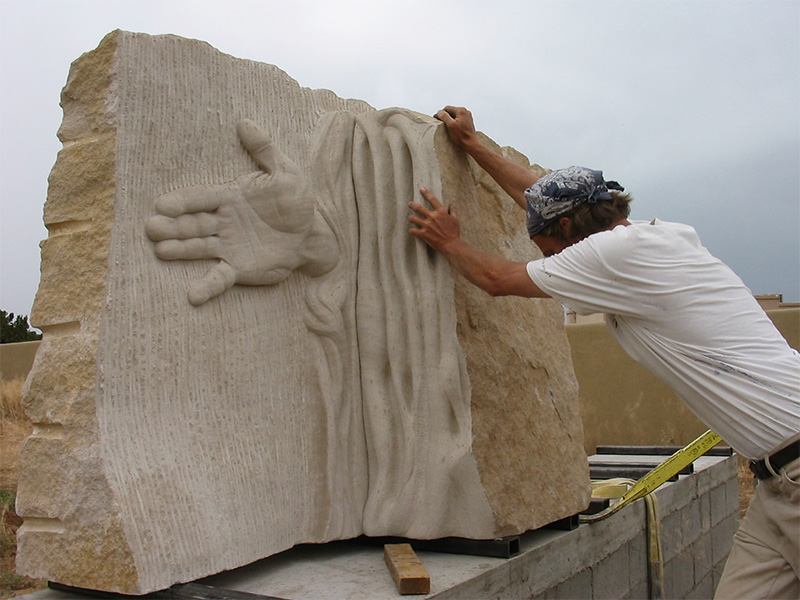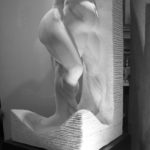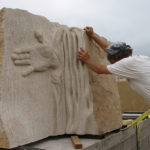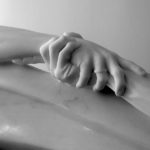Marble, Sculptor and Sculpture
Copyright 2022
Edward Fleming
(two pages)
A marble sculpture, no matter how dynamic, can appear to be a solitary, inanimate object. But in fact, the marble itself originates from an abundance of life and the journey through geology to gallery is epic. Once you’ve heard this story, you will never again look at marble sculpture the same way.
Hundreds of millions of years ago, long before the world’s great mountain chains were formed, sea life lived and died and their bones and shells settled to the sea floors and combined with calcite, formed by the sun evaporating seawater to create limestone. Then, as the earth’s tectonic plates moved, carrying the limestone deposits with them and collided, creating the mountain ranges of the world, the pressure as well as heat from volcanic action metamorphosed the limestone, changing its crystalline structure to marble. So now, the pristine white marble found inside many of the world’s mountain peaks was once the remains of life on the bottom of the sea, so many years ago. Marble originates from life itself.
And human life, since before the time of ancient Greece, has marveled at the beauty and strength of marble and over the last several millennia has found ever more proficient ways to quarry the stone. It took the cavatori (quarrymen) in the Apuan Alps about nine months to extract and deliver the marble block for Michaelangelo’s “Pieta”. Today, 30-ton blocks can be cut and transported from the quarry in a single day. The history of quarrying, the technology, culture and human stories is rich and varied. Many hands touch the marble block before it reaches the sculptor’s studio.
Typically, the huge quarried blocks are delivered to a mill where they are cut into more manageable sizes from large carving blocks to architectural shapes, even floor-tiles. Surrounding the mill is a vast yard where enormous gantry cranes move and store the quarried and cut blocks. Hundreds of people can be working at a modern mill with scores of cutting and shaping machines. This is a very busy, noisy, dusty place.
A sculptor will usually find a quarry or a mill as his or her source of stone. The selection process and negotiations, over time, become friendly but always complex with many details to be considered from a deep knowledge of the marble’s characteristics. Marble has the unique quality of being both very heavy (about 2.5 tons/cubic meter; a marble bust weighs about 100 kilos) and very fragile. So once the carving block has been selected, the sculptor must be very careful moving it to the studio.
Today there is a rapidly evolving technology of computer-aided machine carving that has replaced much of the tradition of marble artisans and some of the sculptors. Here, I’ll describe how a human sculptor makes his or her art and will leave the machines and computers to another discussion. In terms of real art, there is no replacement for the human hand and the heart, mind and spirit that are connected and pass through to the marble. The computer-machines are, in fact, 3-dimensional photo-copiers and what they produce is of similar integrity and value.
Marble carving is subtractive, where the finished form is revealed by removing stone from around the intended form. This is the opposite process from clay/bronze sculpture or painting, where materials are added (and subtracted, then re-added, etc.) and demands from the sculptor a different and very challenging way of visualizing the form. A marble sculptor thinks inside-out. Over the many years required to learn and then master the art-form, stone sculptors develop techniques to “see” the form inside the stone. Their carving moves from the general to the specific, beginning with the heavy work of removing larger volumes of stone surrounding the form and ending with the meticulous work of texturing and polishing the marble. There are about 14 different stages of work along this spectrum, depending on the nature of the finished sculpture and the sculptor’s techniques.
For a typical sculpture, an artist will begin by drawing on the carving block, laying out the general profiles. With that, the roughing out can begin, using large electric grinding machines and industrial diamond cutting blades to slice the marble. Then the slices are broken off by hand with hammer and chisel. Some of this work can also be accomplished by drilling and setting iron wedges to split the stone, breaking off larger volumes of material. Both of these techniques mirror work in the quarry, at a smaller scale. From there the sculptor uses a series of increasingly finer tools (large, medium and small pneumatic hammers and chisels; other types of grinders and burrs; drills, etc.) and a number of stages of work to shape the sculpture so that what began as large bites gradually become smaller bites as the three-dimensional form comes into focus.
Once the general form of the sculpture is created, the detailing begins and the sculptor uses another set of even finer tools to finesse the sculpture. Depending on the subject, this can be an elaborate and more time-consuming process than all the artist’s preceding work.
After the detailing is completed, the final finishing begins. These are the last phases of working the marble surface and where the finish texture(s) are made. During these stages of work the sculptor uses metal rasps (files); texturing tools; fine electric or pneumatic grinders; sanding and polishing with machines and by hand. Often the artist’s final step is to carve his or her name into the sculpture.
If you were to document each step of a sculptor’s progress through a work of art, you’d see at least fourteen different phases. The amount of time of an artist’s life that goes into a sculpture varies depending the scale and scope of the piece and the artist’s experience and skill but it’s not uncommon for a single large, complex sculpture to take as long as a year or more to complete.
An artist-made marble sculpture embodies the sea life in the stone, the lives of many people along the way from the quarry and mill in addition to the life of the artist, who’s hands have shaped and nurtured the marble from block to completed sculpture. Each marble sculpture made this way has a rich history and is completely unique. By definition, nothing can compare.




